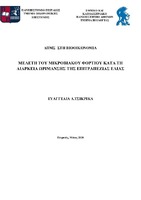Μελέτη του μικροβιακού φορτίου κατά τη διάρκεια ωρίμανσης της επιτραπέζιας ελιάς
Study of the microbial charge during the table olive maturation

View/
Keywords
Λακτοβάκιλλοι ; Επιτραπέζια ελιά ; Ζύμωση ; Ωρίμανση ; LAB βακτήριαAbstract
The first evidence of olive cultivation occurred in Crete during the Neolithic period (6-3 thousand BC). Olive cultivation comprises approximately 11.5 million hectares of olive trees, 58 countries from the 5 continents, and products derived from this activity, namely olive oil and table olives, are consumed in 179 countries.In the world, olive cultivation employs more than 35 million people, representing about 1.20% of the working population. 84% of table olives are consumed in producing countries.Olive fruit (Olea europaea ssp. europaea) is one of the most valuable fruits because of its ecological, economic and cultural importance.There are more than 900 million olive trees worldwide: the Mediterranean basin remains dominant with 95% of world production.Lactic acid bacteria (LAB) represent a significant group of probiotic bacteria including Lactobacillus spp. and Bifidobacterium spp., the most commonly used probiotics other than yeasts. LABs isolated from vegetables have the ability to survive under extreme environmental conditions such as acids, fluctuations in natural and nutritional conditions, and a high concentration of undigested nutrients.This postgraduate thesis attempted to study the microbial charge during the maturation of the table olive. Specifically, dilutions were performed sequentially on the 6 olive samples, inoculated into new plates, colonies cultured, we created fluid and solid culture and glycerol stocks. In addition, a lactobacillus growth experiment with and without sodium chloride (5% w / v NaCl) was performed and finally DNA was isolated by the CTAB method. As far as results are concerned, we counted colonies with and without dilution, made colony observations, and examined the development of lactobacilli with and without sodium chloride. The bacteria were not able to grow sufficiently in sodium chloride and their absorption is constantly decreasing, so after 22 hours the bacteria must have died.This may happened because the bacteria were in an artificial salt environment and not naturally in the olives that we know they are their habitat. In conclusion, we would like to mention that in a future experiment we could place the lactobacilli at different temperatures to see how they develop and what their absorbances are. We would also be able to identify the lactobacilli by targeting the 16s region through PCR (polymerase chain reaction) and get to know in which genus and species they belong to after DNA sequencing.


